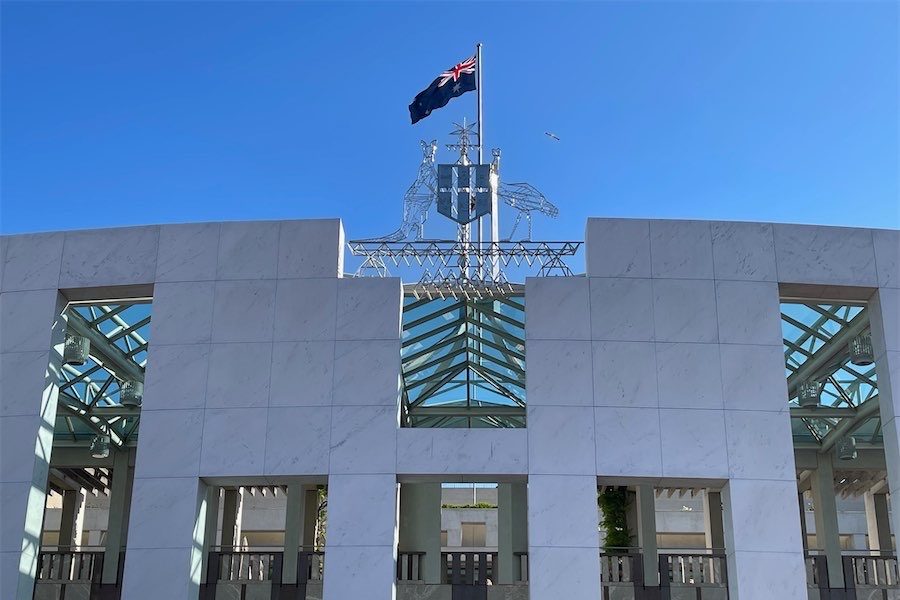
By Marion Rae in Canberra
A big battery will plug into the solar corridor to the south of Canberra, with the profits to go to the taxpayer in a revenue-sharing first.
Located next to existing powerlines and solar farms, construction has begun on Eku Energy’s $400 million project that will bring 200 jobs for local tradies.
The 250 megawatt/500 MW hour Williamsdale battery energy storage system located 35km south of Canberra will store enough renewable energy to power one-third of the capital for two hours during peak demand periods when it comes online in 2026.
A critical energy asset for greater energy security and a bulwark against future price spikes, it is also a crucial step in the fight against climate change, according to ACT Chief Minister Andrew Barr.
Importantly, a revenue-sharing deal means profits from the project will flow to the ACT and pay for more clean energy and other services for a growing population, he said in Williamsdale.
“That is an important principle for our community, who want to see investment in renewable energy and battery storage not only supporting the effectiveness and reliability of our energy network but generating revenue.”
Recently re-elected and already the nation’s longest-serving political leader, Mr Barr says the revenue-sharing model could be extended nationally as a good template for government procurement.
Working with Evoenergy, Tesla Energy and the Australian Energy Market Operator, the Williamsdale battery will also be part of the NSW energy market and the broader east coast energy market.
“The electrons flow in real time so what we would be replacing is the next most expensive form of generation when we dispatch,” Eku Energy chief executive Daniel Burrows told AAP.
It will provide additional supply when the market is tight, which should help lower wholesale prices and support making more clean energy available when it is required, he said.
The battery will also provide more grid security by responding within milliseconds to demand and storing energy when it is abundant.
“What we have in Australia is a prevalence of distributed energy – rooftop solar, large-scale wind and batteries – and a reasonably sophisticated grid,” Mr Burrows said.
“As we’re doing business all around the world, other businesses, other governments, other industry players are looking to what happens here as to how we might manage the energy transition.”
Not a player in a nuclear energy future, he says Eku Energy focuses on projects that are “genuinely the most cost-effective and will stand the test of time”.
A $500 million community grants program set up by the company will be available to eligible local non-profit organisations for employment and education, social and environment initiatives.
Another $500,000 will go to an Australian National University program that has been a testing ground for neighbourhood batteries and other technology.
“Research funding in this area helps ensure we remain at the forefront of advancing technology for a clean energy future,” Battery Storage and Grid Integration Program co-director Heather Logie says.
Minister for Climate Change, Environment, Energy and Water Suzanne Orr donned high-vis gear to shovel dirt alongside Mr Barr in her first public engagement in her new portfolio.
Simon Corbell, the architect of the ACT’s clean energy transition as a Labor minister more than a decade ago, is one of her heroes, she told AAP.
“Everyone has a different journey in coming to politics and mine has definitely been flavoured by the environmental movement,” she said.
Ms Orr, first elected in 2016, replaced former energy and emissions reduction minister Greens Leader Shane Rattenbury in the new government that has taken power without the ACT Greens as a partner.
Canberra has already achieved a nation-leading 100 per cent renewable electricity supply and the ACT is aiming for net-zero emissions by 2045.
The territory is phasing out household gas, with support for households to buy new appliances, electric vehicles, solar panels and batteries.
The Big Canberra Battery project that Mr Barr began as climate action minister will include the large-scale system in Williamsdale and neighbourhood-scale batteries at nine government sites.
Who can be trusted?
In a world of spin and confusion, there’s never been a more important time to support independent journalism in Canberra.
If you trust our work online and want to enforce the power of independent voices, I invite you to make a small contribution.
Every dollar of support is invested back into our journalism to help keep citynews.com.au strong and free.
Thank you,
Ian Meikle, editor









Leave a Reply